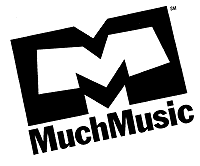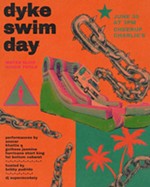Better Than MTV
Canada's Much Music Network
By Kayte VanScoy, Fri., May 9, 1997
|
|
A peek inside the windows reveals an unlikely combination: the frenetic buzz of a busy office complete with cluttered desks and glowing computer screens dropped into the midst of the colored lights, cables, and machinery of a television studio. But don't you dare call it a studio. This is the Much "environment," and it is not only reinventing music programming, it is weaving into the fabric of television an organic interactivity which encompasses everything from the webpage to the street.
Much Music launched across Canada in 1984, but only traversed stateside three years ago. In addition to foreign language affiliates from Mexico to Finland, Much is currently broadcast in six U.S. cities, but it has designs on every major U.S. market. The best-kept secret in Austin is the Much broadcast here on UHF channel 9. But, if your television does not pick it up, blame the University of Texas. The student-run channel can only broadcast in an approximately 20-block radius. Austinites lucky enough to tune in, however, have probably noticed that Canadians have a different definition of music television from MTV. For starters, it includes music.
It does not take long to realize, though, that something more is afoot than simply playing more videos more of the time. Everything about Much's attitude speaks to a nearly religious devotion to its founder Moses Znaimer and his goal to "bring the audience as close to us as we can." Instead of installing equipment behind a glass wall, Much installed 32 "hydrant" outlets which allow lights, cameras, and sound equipment to plug in anywhere in the building. "We want to show the process of TV, as well as the product," says director of programming Denise Donlon, explaining why ringing phones and cheeky camera crew are all part of the deliberately laid-back delivery. And something about showing off the underpinnings of production makes Much imminently approachable for its audience.
"We believe the way to speak to the community is to reflect the community," says Donlon, explaining that the veejays bear out this filial camaraderie between audience and network. In nationwide searches, the network finds people without performance backgrounds who also come from a variety of ethnic groups. "Real people are fascinating veejays," states Donlon. Naturally, everyone and his brother tries out for the job, and the lucky winner is not necessarily the most polished contender. "The veejays learn and grow on the air, and the audience grows with them," says Much publicist Carla Lucchetta.
However, it is the network's devotion to audience participation which is the greatest testament to their interactive foundation. RSVP, a daily all-requests hour, takes live viewer input by phone, fax, and e-mail, and every other show includes requests in their format as well. Often the camera will zero right down to a computer screen while the veejay reads an e-mail message. Seeking a real-time dialogue between a mass audience, Go With The Flow brings live broadcast feed to the Much webpage while simultaneously delivering the corresponding Internet chat to the television viewer. And for the truly huge -- Beck, No Doubt, Bush -- there are Intimate & Interactive specials combining a live performance in the Much environment and technological interaction with the superstars. Furthermore, it seems that, given the opportunity, viewers not only will agree to participate in the process, they will demand it. "If we put a foot wrong in terms of a playlist choice, we hear loud and quickly from our audience," says Donlon.
The most populist, democratic choice at Much, however, is also such a quiet constant in the programming that it takes a while to sink in. The natural outgrowth of the network's desire to respond to the individual viewer is to bring his favorite hometown band to national attention. In fact, Much's dedication to exposing unknown, unsigned, or independent bands to a national audience is unrivaled in U.S. television or radio. "The beauty of Much is that it will say `This is a genre that deserves exposure throughout the day, not just on one show,'" says Jones. The best source of up-and-comer bands available anywhere is The Wedge, which plays every weekday in Austin at 4:30pm. The Wedge is Much's answer to MTV's 120 Minutes, featuring indie band performances and off-the-wall videos. On a typical day The Wedge might air Black Flag, Stereolab, and Squirrel Nut Zippers back-to-back. More significantly, The Wedge plays during the day five times a week, it is not the indie black sheep tucked away in the wee hours of a Sunday night like 120 Minutes.
Znaimer's unique interactive vision is at the heart of the success of Much. He developed his philosophy at the dawn of Much's parent network, CityTV, in the 1970s when "interactivity" still meant simply "audience participation." So, instead of merely reacting to the increased opportunities for hard-wired interactivity, Much has been able to fully exploit the Internet as a tool for the dream that Znaimer already had in motion. "The key is that you have to lead the technology, not the other way around," explains Jones.
Since making a splash in the online world seems to depend not on utilizing technology, but on mastering audience interest, Much had a leg up a decade before the Internet arrived. And now it is reaping the rewards. "While interactive and new media divisions all over are being scaled back or terminated, Much's website continues to thrive, financially as well as creatively," boasts Much Webmaster David Hutchinson.
 To say that MTV is offering nothing comparable to Much's level of viewer participation, not to mention live programming, would be a grave understatement and therein lies the key to Much's hidden strength. At a time when nationwide boredom with MTV's endless parade of pandering, sophomoric programming is already a cliché, Much is poised to pounce on the market. "The betrayal of trust between a station and its audience is the most grievous error you can make," says Donlon of her U.S. competition. "If we were in the situation where the viewer told us that they were bored and dissatisfied, we'd listen."
To say that MTV is offering nothing comparable to Much's level of viewer participation, not to mention live programming, would be a grave understatement and therein lies the key to Much's hidden strength. At a time when nationwide boredom with MTV's endless parade of pandering, sophomoric programming is already a cliché, Much is poised to pounce on the market. "The betrayal of trust between a station and its audience is the most grievous error you can make," says Donlon of her U.S. competition. "If we were in the situation where the viewer told us that they were bored and dissatisfied, we'd listen."
Oh, MTV is listening all right. Anyone familiar with Much would catch on instantly to the similarity between Much and M2, MTV's music-only experiment, available only by satellite. As Much continues to seep out of Canada, though, expect more than the music industry to take notice. Challenging the technology to create more and better interactivity instead of contriving merely to utilize the tools available, Much may lead the way to defining the coming collaboration between computers and television by looking for answers away from the machinery and concentrating on the audience.







